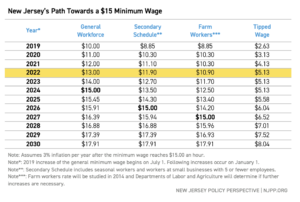Many New Jersey minimum wage workers will ring in the new year with a welcome boost in their pay from $12 to $13 an hour. For a full-time minimum wage worker, the increase brings $2,080 more in annual income. This is the latest scheduled increase under the 2019 state law that raises New Jersey’s minimum wage to $15 an hour, for most workers, by 2024.
Unfortunately, though, not all minimum wage workers will be treated alike. Phase-in schedules vary across job sectors. Farm workers’ wages, for example, will rise only to $10.90 an hour in 2022 and won’t reach $15 until 2027. For workers who rely on tips for much of their income, the minimum wage will rise to a mere $5.13 in 2022. Of course, not every restaurant server makes up the difference in tips; their treatment under the law is an inequitable shortcoming.

Overall, inadequate wage growth makes it difficult for far too many working families — including many families of color — to pay for necessities. For low-paid workers, the past 20 years have been less about building economic security and improving their living standards and more about the struggle to simply stay afloat. With wages no longer keeping pace with increases in productivity, let alone inflation, minimum wage workers only see boosts in their pay when the state commits to raising their living standards.
Minimum wage increases are one of the most effective policy tools to boost the incomes of the lowest-paid workers. These raises help workers better afford basic needs, like food and transportation, and help more families cope with increased financial pressures, such as the COVID-19 pandemic and recession. Many of these low-paid workers lost weeks or months of wages during the pandemic, including many undocumented workers who have been forced to make ends meet with minimal government relief.
More work remains before all workers can live with dignity, meet basic needs, and have an opportunity to thrive. Thankfully, New Jersey’s minimum wage law positions working families for a stronger pandemic recovery — and the state with a stronger economic future.

